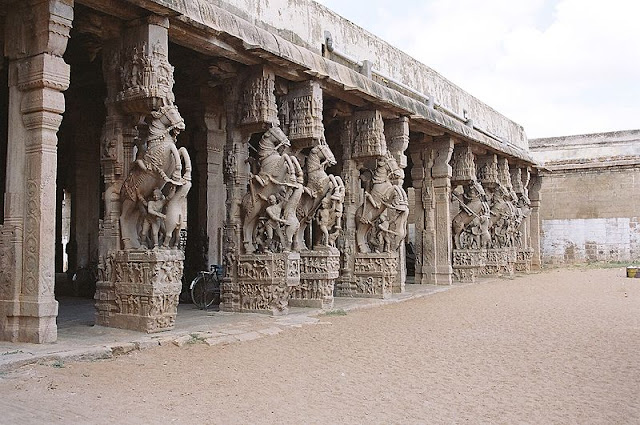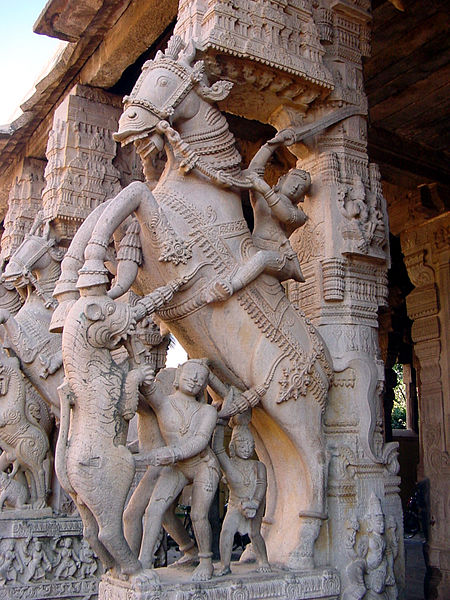Ranganathaswamy Temple, Srirangam – Mandapams (Halls)
Thousand Pillared Hall:
On the
northeast side of the temple is the impressive "Hall of a Thousand
Pillars." Each of the 5.5m (18 ft.) granite pillars is intricately carved.
This hall actually has only 953 pillars. In the center of the hall is a
pedestal shaped like a processional car. During Vaikuntha Ekadasi, the
processional deity is brought to this pedestal before going on
procession. The Hall of 1000 pillars (actually 953) is a fine example of a
planned theatre-like structure and opposite to it is the "Sesha
Mandap".
The
1000-pillared hall made of granite was constructed in the Vijayanagara period (1336–1565) on the site of the old
temple. The pillars consists of sculptures of wildly rearing horses
bearing riders on their backs and trampling with their hoofs upon the heads of
rampant tigers, seem only natural and congruous among such weird surroundings.
The
great hall is traversed by one wide aisle in the center for the whole of its
greater length, and intersected by transepts of like dimension running across
at right angles. There still remain seven side aisles on each side, in which
all the pillars are equally spaced out.
Rangavilas Mandapam:
The
Rangavilas Mandapam hall is located directly in front of the southern gate of
the fifth Enclosure. Next to this (to your left as you enter the southern gate)
is the small, intricately carved Venugopala Temple. Inside the porch of the
Venugopala Temple there are paintings which show Krishna having pastimes with
the gopis (cowherd-girls).
Garuda Mandapam:
The
Karthikai gopura in the third enclosure of the Sri Ranganathaswamy Temple leads
to the Garuda Mandapam that has 14 rows and is the most beautiful Mandapam in
the Temple. The Garuda Mandapa (hall of the legendary bird deity
of Vishnu, garuda) located on the south side of the third enclosure is
another Nayak addition.
Courtly
portrait sculptures, reused from an earlier structure, are fixed to the piers
lining the central aisle. A free-standing shrine inside the hall contains a
large seated figure of garuda; the eagle-headed god faces north towards
the principal sanctum. The light and airy mandapa (17th century) fronts the
south entrance to Enclosure 3, its aisles defined by piers with attached colonettes. The roof is supported by corbeled bracketing.
Kili Mandapam:
The Kili
Mandapam (Hall of parrot) is located next to the Ranganatha shrine, in the
first enclosure of the temple. Elephant balustrades skirt the access steps that
ascend to a spacious open area. This is bounded by decorated piers with rearing
animals and attached colonettes in the finest 17th-century manner. Four columns
in the middle define a raised dais; their shafts are embellished with
undulating stalks. The embellished shafts, stalks and balustrades depict
the decorations in Kili Mandapa, a hall named after parrots.
A long
frieze running the basement of the Kili mandapam from its northern
and right up to the side steps leading on to it contains a number of panels
depicting figures in high relief in different dance poses. The panels are
intercepted at regular intervals by projecting niches containing stone figures
in the round. Most of these are now missing and the only sculpture now
existing seems to depict Vishnu with four arms, in standing posture. The
dance-poses of these panels are worth detailed study.
Tondaiman Mandapam:
The
Tondaiman Mandapam is located in the first enclosure and the ceiling is
decorated with paintings.
Kambar Mandapam:
While
staging the Kamba Ramayana in the temple, some objected to the mention of Lord
Sri Narasimha in the Ramavatara story. Kambar said that he would
withdraw this part of the epic, if Lord Himself so demanded. Lord
Sri Narasimha emerged from a pillar and approved Kambar’s writing as
true. Lord Narasimha in the temple graces from a separate shrine in
the name of Mettazhagia Singar near the Mother’s shrine. The Mandapam where
Ramayana Arangettram took place is opposite the Mother’s shrine.
Arjuna Mandapam:
The
eastern part of the first enclosure contains two Mandapams - Arjuna Mandapam
and Kili Mandapam.
Shesha Mandapam:
The
Shehsaraya Mandapa (Horse court Hall) is on the east side of the temple. It has
8 intricately carved monolithic pillars of men on rearing horses. The most
artistically interesting of the halls that the Nayaks added to the complex
is the Sesha Mandapam on the east side of the fourth enclosure. The
hall is celebrated for the leaping animals carved on to the piers at its
northern end.
The
walls of this hall is inscribed with pictures of war horses with
soldiers on the back that raise their hoofs to kill a wild animal, which give a
weird feeling in such serene temple premises. The leaping animals like Leopard
find their place in the Sesha mandapa, an exclusive and unique add-on to the
piers of 4th enclosure to the temple donated by Nayak Dynasty.
The
aisles in the hall are equally spaced out and the court related sculptures are
religiously preserved. Exotic figures beneath the rampant horses include a
fanciful elephant-lion, and a Portuguese
soldier wearing a European hat and tunic can be found
in this mandapam. The interior of the mandapa contains images of all ten of
Vishnu's major incarnations.
A
sculpture showing Matsya, the fish that saves mankind during a great flood can
be found in this Mandapam. The recently made colored marks indicate that the
statue is currently a subject of devotion. Sculpture showing Hanuman was
swallowed by a crocodile. He defeated the crocodile by growing to giant size
and using his supernatural strength to escape.


























































